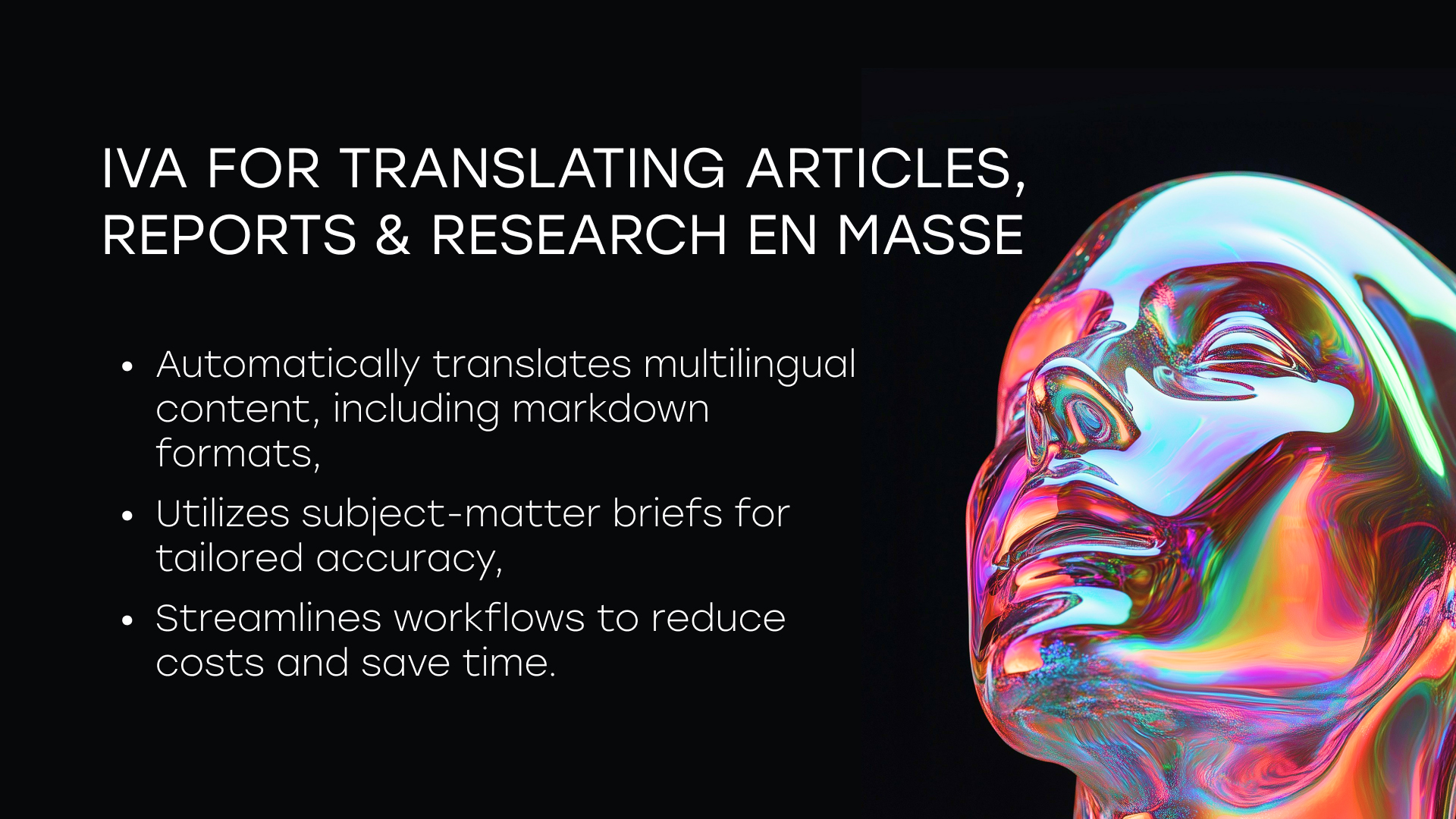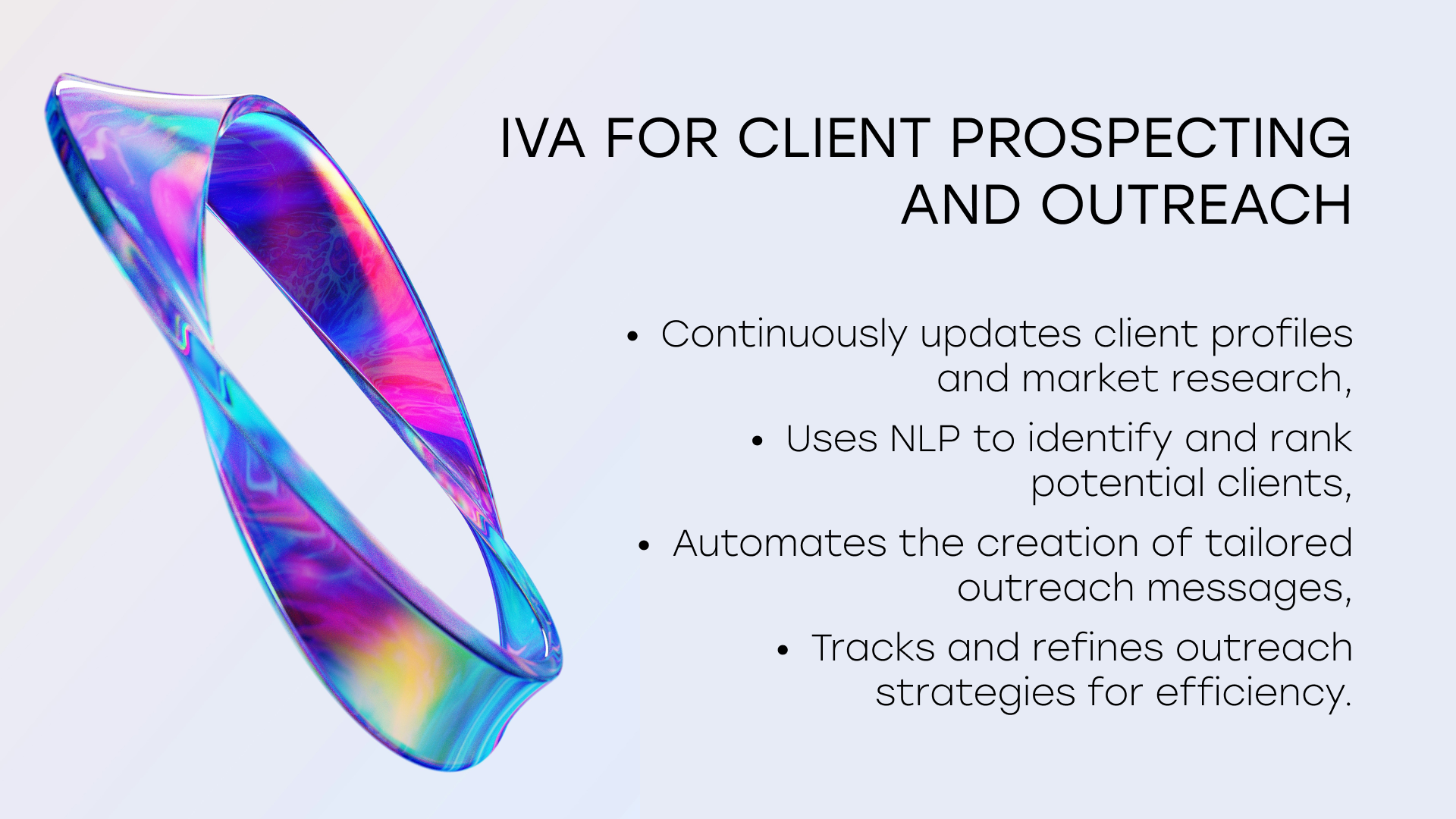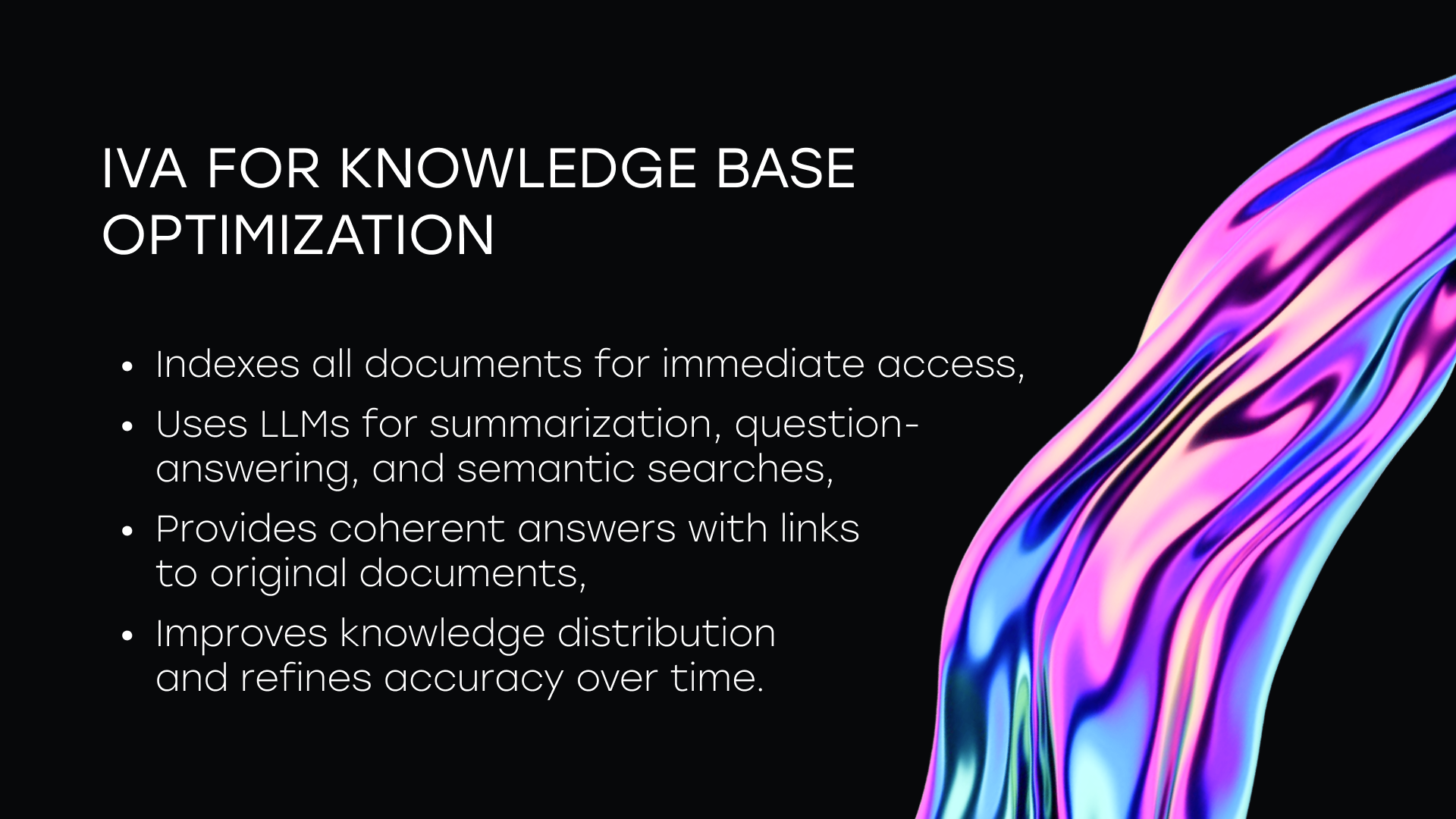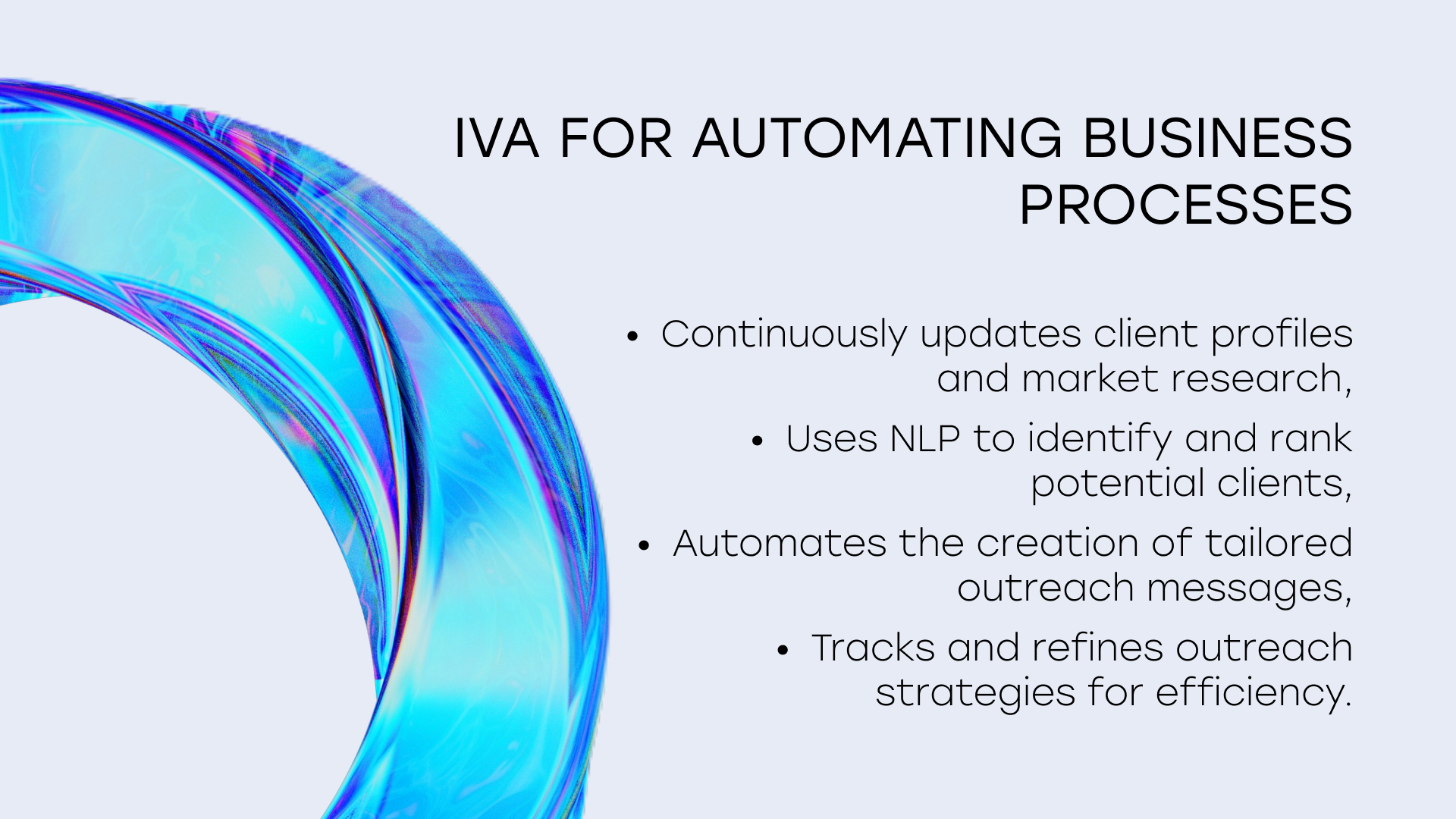In today’s fast-paced business environment, organizations are turning to Intelligent Virtual Assistants (IVAs) to streamline operations, enhance customer experiences, and drive efficiency.
This article explores what IVAs are, how they work, examples of their real-world applications, and practical steps to implement them effectively.
Continue reading to find out how IVAs:
- Help companies translate articles and documentation en masse,
- Aid in expanding into international markets and identify companies that would benefit most from the company’s services,
- Optimize knowledge bases,
- Help achieve unprecedented efficiency through business process automation with Domain-Specific Language (DSL).
Describe your idea and get an estimation for your AI project
What is an Intelligent Virtual Assistant (IVA)?
An Intelligent Virtual Assistant (IVA) is an advanced software agent designed to perform tasks and provide services on behalf of users, leveraging artificial intelligence (AI) technologies like natural language processing (NLP), machine learning (ML), and sometimes speech recognition and synthesis.
Unlike basic chatbots, which follow pre-programmed scripts, IVAs possess contextual understanding and can engage in dynamic, conversational interactions that mimic human communication.
IVAs are equipped with the ability to learn from user interactions, adapt to preferences, and improve their performance over time.
They can understand and process both spoken and written inputs, enabling them to perform complex tasks, such as scheduling meetings, managing emails, providing customer support, analyzing data, or even offering personalized recommendations.
By integrating with various business systems and applications, IVAs can automate repetitive tasks, enhance user experiences, and streamline workflows.
This capability not only boosts operational efficiency but also allows employees to focus on higher-value activities, contributing to increased productivity and customer satisfaction.
In today’s digital landscape, IVAs are becoming an integral part of business strategies across industries, revolutionizing how organizations interact with customers, employees, and stakeholders.
Intelligent Virtual Assistant vs. Chatbot
While Intelligent Virtual Assistants (IVAs) and chatbots are often used interchangeably, they have distinct differences in terms of functionality, complexity, and application.
|
Feature |
Chatbot |
Intelligent Virtual Assistant (IVA) |
|
Level of Intelligence |
Rule-based, limited context understanding; cannot handle unexpected inputs. |
Advanced AI with machine learning and NLP; capable of understanding context and handling complex queries. |
|
Scope of Functionality |
Best for simple, repetitive tasks like FAQs and basic customer support. |
Performs complex tasks like task automation, data analysis, and personalized recommendations. |
|
Interaction Style |
Relies on keyword recognition; responses may feel robotic and constrained. |
Engages in natural, human-like conversations with contextually relevant responses. |
|
Learning & Adaptability |
Requires manual updates to expand functionality; lacks learning capabilities. |
Continuously learns and improves from interactions using machine learning. |
|
Integration Capabilities |
Standalone solution with limited integration options. |
Integrates seamlessly with various tools, applications, and systems for comprehensive solutions. |
Chatbots are valuable for handling straightforward tasks and providing basic user support, making them suitable for simple applications. On the other hand, IVAs offer a more sophisticated, versatile, and human-like experience, making them ideal for businesses seeking to enhance user engagement, streamline workflows, and achieve greater efficiency.
How do IVAs work?
IVAs operate by leveraging a combination of advanced technologies to deliver intelligent and personalized interactions. The process can be broken down into three key stages:
1. Understanding User Input
At the heart of an IVA’s functionality is its ability to understand and interpret user inputs. When a user interacts with an IVA, either through text or voice, the assistant uses natural language processing (NLP) to analyze the input.
NLP enables the IVA to extract intent, identify relevant keywords, and even gauge the sentiment or tone of the communication. In the case of voice interactions, speech recognition technology is employed to convert spoken words into text, allowing the IVA to process the request effectively.
.png)
This stage is critical for ensuring the IVA can accurately interpret the user’s needs, regardless of the complexity or context of the query.
2. Processing and Decision-Making
Once the input is understood, the IVA moves to the decision-making phase. Here, advanced AI algorithms and machine learning models analyze the request to determine the appropriate response or action.
This often involves integrating with external databases, APIs, or enterprise systems to retrieve relevant information or execute specific tasks.
For example, an IVA might query a CRM system to pull up customer details or schedule a meeting by checking the user’s calendar. The decision-making process is powered by a combination of rule-based logic and probabilistic models, ensuring the IVA can handle both straightforward requests and more nuanced scenarios with precision.
3. Generating and Delivering Responses
The final stage involves generating a response that is both accurate and contextually appropriate. Using natural language generation (NLG), the IVA formulates replies that are easy for the user to understand and align with the conversation’s context.
These responses can be delivered as text in a chat interface or converted to speech using text-to-speech (TTS) technology for voice interactions.
Beyond simply responding to queries, IVAs continuously learn from each interaction by analyzing patterns, gathering feedback, and updating their algorithms. This enables them to improve over time, becoming more effective and personalized with consistent use.
Benefits Of Using Intelligent Virtual Assistants
IVAs offer a multitude of advantages for businesses, revolutionizing operations and improving interactions at multiple levels. Below are some of the key benefits:
Delivering Exceptional Customer Support: IVAs provide tailored, context-aware communication that feels personal and responsive, creating stronger relationships with customers. For business owners, this translates into higher customer satisfaction and retention rates, which directly impacts revenue.
Automating Routine Tasks: Repetitive processes like booking appointments, managing schedules, or responding to common inquiries are automated with IVAs. Business owners benefit by freeing up their staff to focus on strategic, revenue-generating activities, reducing operational inefficiencies.
Scaling Customer Service Without Extra Costs: IVAs handle unlimited interactions simultaneously, enabling business owners to scale customer service without hiring additional staff. This is particularly valuable during seasonal peaks or marketing campaigns that increase customer inquiries.
Ensuring 24/7 Business Availability: With IVAs, businesses remain accessible around the clock, ensuring customer needs are met even outside of standard working hours. For business owners, this enhances brand reputation and accommodates international customers in different time zones.
Gaining Actionable Insights: IVAs collect and analyze interaction data, offering business owners valuable insights into customer preferences, pain points, and trends. These insights can guide product development, marketing strategies, and overall decision-making to drive growth.
Enhancing Employee Productivity: IVAs can support employees by handling administrative tasks, providing quick access to company resources, or assisting with onboarding. This increases employee productivity, enabling teams to focus on high-priority initiatives that drive business success.
Cutting Costs Significantly: Automation through IVAs reduces the need for large customer support teams and manual labor, resulting in significant cost savings. For small business owners, this means achieving operational efficiency without compromising service quality.
Maintaining Consistent Brand Voice: Across multiple platforms like websites, apps, and social media, IVAs ensure a consistent tone and message. This strengthens the brand’s identity and helps business owners establish trust and credibility with their audience.
Adapting to Changing Business Needs: IVAs continuously improve through machine learning, adapting to new customer demands and evolving business goals. Business owners can count on their IVA to remain effective and relevant as their operations grow or change.
By addressing these specific business challenges, IVAs empower business owners to optimize operations, enhance customer relationships, and achieve long-term success.
Virtual assistant AI examples
Virtual Assistant AI Examples: Translation and Content Management

Many businesses face challenges when managing multilingual content, especially if they produce large volumes of articles, reports, or research.
For example, imagine a company with 500-700 articles on its website, updated regularly and requiring translation into multiple languages such as Chinese, French, German, and Spanish. Historically, this might involve costly human translators working through updates manually, often leading to unpredictable workloads and high monthly expenses.
To solve this, businesses are turning to virtual assistant AI like ChatGPT. These systems handle multilingual translation by processing markdown-formatted content, complete with graphics, styles, and formulas.
By including subject-matter briefs and examples of past translations, businesses ensure AI-generated translations meet their specific needs. The AI delivers translations that, while not perfect, are accurate enough for immediate publication.
This process saves businesses significant time and money while maintaining a multilingual content base that enhances their reputation and appeals to a global audience.
Implementing such AI solutions transforms tedious translation tasks into efficient workflows, empowering businesses to focus on their core objectives.
Virtual Assistant AI Examples: Client Prospecting and Outreach

Another powerful use case for virtual assistant AI lies in client prospecting and outreach.
Imagine a business seeking to expand into international markets and identify companies that would benefit most from its services. Traditional methods of prospecting, relying on manual research and outreach, are time-intensive and often yield inconsistent results.
With the latest advancements in AI, businesses can now leverage virtual assistants to automate and optimize this process. A comprehensive system includes a knowledge base storing vast amounts of internal and external data, including market research and potential client profiles. Automated web crawlers continuously update this database by scanning online publications, reports, and news related to potential clients.
Here how it works:
- When a user requests a list of prospective companies, the AI employs advanced natural language processing (NLP) and machine learning models to interpret the query, conduct targeted searches, and rank the most relevant results. For example, an AI could respond to a prompt like, “Find companies in the renewable energy sector that might need consulting services,” by identifying businesses with growth challenges or expansion plans,
- The IVA can draft personalized outreach emails or proposals, tailored to the specific needs and circumstances of each prospect. This saves businesses countless hours and ensures consistent, high-quality communication,
- Additionally, by integrating these tools with CRM systems, companies can track and refine their outreach strategies over time.
These systems represent a significant leap forward in sales and business development, allowing organizations to scale prospecting efforts without proportionate increases in resources. They deliver actionable insights and open the door to new markets, empowering businesses to grow strategically and efficiently.
Virtual Assistant AI Examples: Knowledge Base Optimization

For companies with extensive internal knowledge bases, traditional search functionalities are often insufficient. Employees and customers struggle to locate relevant information, leading to inefficiencies and frustrations
A virtual assistant AI designed for knowledge base optimization addresses these challenges by making internal documentation more accessible and actionable.
- Such a system begins by indexing all available sources of information into a vectorized database capable of full-text search and real-time updates. This ensures that even newly added documents are readily available.
- Large language models (LLMs) are then used to build additional indices for summarization, question-answering, and semantic search, enabling more nuanced and precise query results.
- When users pose a question, the AI interprets their intent, searches across all indexed sources, and synthesizes an accurate, coherent response complete with links to original documents for verification. For instance, an employee onboarding a new hire might ask, “Where can I find the product design guidelines?” and receive a detailed response linking to relevant resources across different repositories.
- The AI also supports self-service by improving knowledge distribution and reducing dependency on subject-matter experts. As users interact with the system, their feedback is logged to refine responses and improve accuracy over time. Streaming and parallel query processing further enhance performance, ensuring timely results even for complex queries.
This approach minimizes time spent searching for information, enhances onboarding processes, and empowers employees to work more effectively. Companies benefit from increased productivity and reduced strain on internal support teams, making knowledge base optimization a high-impact application of virtual assistant AI.
Virtual Assistant AI Examples: Business Process Automation with DSL

Some companies, especially those operating at the intersection of technology and analytics, leverage virtual assistant AI to achieve unprecedented efficiency through business process automation.
One innovative approach involves the creation of a Domain-Specific Language (DSL) tailored to the company’s internal operations. This DSL integrates seamlessly with existing systems like issue trackers, email platforms, custom CMSs, and proprietary analytics tools.
A DSL simplifies complex workflows by allowing employees to write straightforward scripts that instruct the virtual assistant to perform multi-step processes. For example:
- When a client email arrives, the system summarizes the client’s profile, recent interactions, support requests, and business inquiries. Based on this summary, the assistant drafts potential responses for review,
- During contract negotiations with a new client, the assistant cross-references the company’s compliance checklist with FAQs and historical client interactions. It then generates accurate, context-aware responses for each item on the checklist.
By encapsulating these processes in a programmable language, employees avoid dealing with intricate API calls, retries, or manual system navigation. Instead, they interact with a unified interface powered by the virtual assistant. The DSL also supports versioning, enabling iterative improvements and ensuring long-term scalability.
This approach reduces reliance on manual intervention, streamlines complex workflows, and allows businesses to scale efficiently without proportional increases in headcount. For companies aiming to grow predictably and sustainably, implementing such a system transforms their operational landscape, enhancing productivity while maintaining high-quality service standards.
How to Implement IVAs
Implementing Intelligent Virtual Assistants (IVAs) requires a well-planned strategy to ensure they meet specific business needs and deliver maximum value. Here’s an expanded overview of the four key steps involved:
1. Define Objectives and Use Cases
The first step is to clearly define the goals you want the IVA to achieve.
Identify specific problems, such as reducing customer support response times, automating lead generation, or optimizing internal processes. For example, if your objective is to streamline customer support, determine measurable goals like cutting average response times by 50% or handling 10,000 inquiries monthly.
Establishing these benchmarks ensures that the IVA’s performance can be effectively evaluated.
Additionally, prioritize use cases that align with your organization’s immediate needs and have the highest potential for impact.
2. Select and Configure the AI Platform
Choosing the right AI platform is critical to the success of your IVA implementation.
Select a platform that supports advanced natural language processing (NLP) and integrates seamlessly with your existing tools, such as CRM systems, knowledge bases, and internal databases.
Platforms like ChatGPT, Microsoft Azure AI, or Google Dialogflow can be customized to fit your unique requirements.
During configuration, ensure the platform has access to all necessary data sources, such as customer inquiries, internal documents, and product catalogs.
Setting up APIs or middleware for seamless data exchange is also essential for smooth operations.
4. Train and Test the IVA
Training the IVA involves feeding it relevant data to help it understand your business’s specific context.
This includes FAQs, customer histories, and user manuals. Machine learning techniques can be used to fine-tune the IVA, enabling it to handle industry-specific terminology and nuanced queries.
Testing is equally important—simulate real-world scenarios to evaluate the IVA’s ability to respond accurately and efficiently.
Gather feedback from a pilot group of users, refine the assistant’s algorithms based on their input, and ensure it provides contextually relevant and satisfactory answers.
Launch, Monitor, and Optimize
After a successful training and testing phase, the IVA is ready for deployment.
Launch it across your chosen communication channels, such as your website, mobile app, or messaging platforms.
Post-launch, continuously monitor the IVA’s performance metrics, such as user satisfaction, response accuracy, and resolution rates.
Encourage users to provide feedback, and use this input to make iterative improvements.
Optimization is an ongoing process—fine-tune the assistant’s capabilities to adapt to evolving business needs and ensure it remains a valuable asset to your organization.